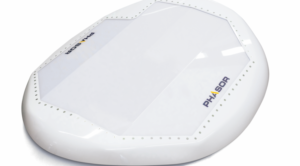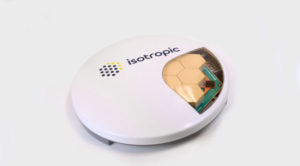By Helen Jameson

The flat panel antenna – or FPA – is being heralded as the key to realising the potential of the new raft of mega constellations that have come to characterise the New Space movement – a new era in satellite technology and communications.
In a newly released report, Flat Panel Antennas, 4th Edition, analyst firm NSR predicts that FPA equipment sales will reach approximately U.S.$11 billion by 2028 with aeronautical antennas driving revenue growth for manufacturers and fixed broadband applications on Non-GEO satellites as the main volume market.
With OneWeb’s first satellites lofted last week, it’s a pertinent time to look a little deeper into what this new wave of antennas will bring to users and the benefits they will offer as well as the challenges faced in terms of making these FPAs affordable.
We all want to stay connected
The mobile device has well and truly permeated our lives and today, our expectations of connectivity are higher than they have ever been. We want to use our devices everywhere – on the train, on an aircraft, at sea – ubiquitous access is what it’s all about. This is why the new mega constellations are set to have such an impact, offering the ubiquity that satellite does so well, yet at low latency due to their much closer proximity to Earth (in Low Earth Orbit and Medium Earth Orbit). This means that high-speed, mobile connectivity can be experienced no matter where the user is. The problem is, however, that traditional parabolic antennas do not offer the ‘make-before-break’ capability that the new satellite constellations require. The ground segment to accompany these new constellations has been somewhat forgotten in the excitement of the space segment development but the importance of this is now being recognised and now FPA developers are out in force with different technologies that will enable these constellations to realise their potential.
NSR calculates that there are a total of twenty three manufacturers are varying stages of development. Kymeta already has antennas deployed commercially and Phasor is expecting to bring their Electronically Steered Antenna to market later this year and there are many others – Isotropic Systems, Alcan, C-COM, ThinKom, Viasat and Gilat to name but a few. This makes for a healthy and competitive market and should result in more successful and wide ranging business models.
Why FPAs?

The small satellite constellations that we are anticipating from the likes of OneWeb, SES, SpaceX and Telesat, will features fast moving satellites that pass across the sky and then dip below the horizon, unlike traditional GEO satellites that remain at a fixed point in the sky. The antenna serving the user must be able to track the satellite until it disappears over the horizon whilst tracking another satellite before the first link is broken to ensure continuity of connectivity. This is a complex technological challenge.
Then there is the issue of traditional parabolic antennas. The size and weight of these antennas make them largely unsuitable for mobile applications on aircraft, buses and trains for example, where the vehicle will move at high speed. The benefit of using an FPA is obvious – they are low-profile, streamlined and aerodynamic as well as being much lighter. In addition, and very importantly, they are solid state which means that they have no moving parts to go wrong and replace. The parabolic antennas of today have a lot more that can go wrong which can be costly and take a service down. With a solid state FPA, this will be a great deal less of a problem.
The Cost Issue
The development of FPAs takes time, blood, sweat and tears, and the technology and components behind these antennas means that they are inevitably going to come at a cost. FPAs are in use by the military, for example, but they are expensive and to introduce them to the wider market they must be affordable.
Discussions on the FPA panel at the Satellite Innovation Symposium at the end of last year highlighted that manufacturers do take very different views on how affordable these antennas can be and whether they will be in within reach of the consumer. Some manufacturers argue that economies of scale will push the prices of antennas down. However, others believe that this is not going to be a consumer market and the terminals will be highly suitable for enterprise applications such as airlines, train operators and bus companies where they will provide connectivity for passengers and to improve overall daily operations through useful applications such as monitoring and improved communications.

The fact is that this is going to be a wide market with a range of terminals that satisfy a range of applications. A consumer FPA is going to be very different to an FPA for enterprise use and they are at opposite ends of the market.
In terms of early adopters of FPA technology, the aviation, government and land mobile market are expected to be the clear drivers. Connectivity for commercial aviation is growing all the time as passengers expect more from their inflight experience and airlines realise that they have a lot to gain from satellite connectivity from an operational perspective. Referring back to their report, NSR expects 94% of all revenues to come from mobile applications – this is where the FPA sweet spot is going to be.
Like all things new in the satellite industry, there are going to be delays. Things take longer than expected and this kind of complex technology takes time to deliver. Although FPA technology is not new per se, it is in a new phase of development that will make it accessible to the many, not just the few. There’s no doubt that the combination of small satellite mega constellations and these new FPAs will bring about fundamental change in access to satellite connectivity the world over. With the first of the smallsat constellations being deployed, these are exciting times. However, it is worth remembering that we haven’t been here before. This is new territory for the satellite industry. There will be no one-size-fits-all FPA and different companies will fulfil different requirements. But for anyone that relishes new developments in the satellite industry, it’s going to be very interesting to see how this new market unfolds.
Helen Jameson is the Editor-in-Chief of SpaceWatch.Global.
 SpaceWatch.Global An independent perspective on space
SpaceWatch.Global An independent perspective on space




